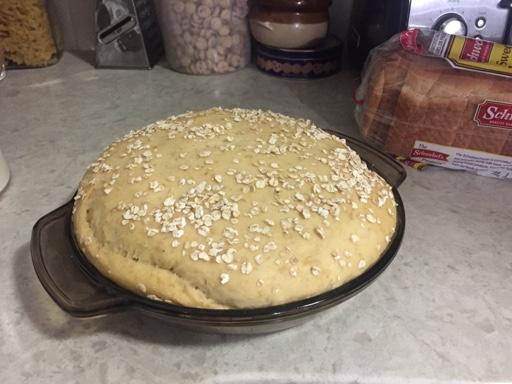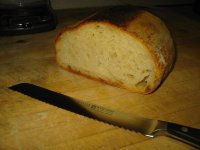I bake a a loaf about twice a week. It takes about half an hour prep time for the dough, proofing in the fridge overnight, then 30 minutes involved in baking. That's not total time, just how much time actually working at it. No strenuous kneading involved. Just mix it and do stretch and fold a few times, and moving it from here to there. But it took me two years to sort out what works and what was just extra work, plus investing a couple several hundred bucks in equipment such as a timer, a scale, several batons to find one I liked, a couple Dutch ovens, and a proofing box with temp/humidity for proofing (only needed if your kitchen temp is below 70F or so in winter). Also a wide bench scraper and air tight containers so I can store a 25 pound sack of flour. But the bread is much better than store bought and ingredients cost about 35 cents for a 20 oz. loaf. Something about baking my own bread feels really good, and not having to go to the store so often is a plus. And it only gets better over time as I tweak the process.
What type of bread do you make? That might be a good place to start - a simpler loaf, rather than croissants.
I can't imagine myself not staking a stab at bread at some point, but I'm not sure where I'd start.
I've always been a bread lover since I was a kid. So far I'm just using white flour, although I'm particular about quality, and one with very good flavor and respected for consistency is King Arthur's. The better one's for bread have high protein content for stronger gluten development. The reason I stick with AP flour is it provides the highest protein level and best rise. ("Bread flour" is extra high but costs a lot more.) Adding whole wheat flour adds good flavor but it has less protein plus the tiny bran shards break apart the gluten strands. Good rise is all about proper gluten development that occurs during kneading and proofing. I get a 25 pound bag at Costco for about $12.50. That works out to about 65 cents for a 20 oz. loaf (not 35 like I stated earlier). 16 oz. of flour, 1 tsp. Fleischman's Instant Yeast, 1 tsp. sugar, 1 tsp. salt, 12 oz. of cold well water (no chlorine that might harm the yeast), and 1 oz. olive oil. I use pickling salt because it doesn't have iodine in it which might harm the yeast. Those little packets of yeast can be expensive so I buy a pound online and keep it in the freezer in sealed deli containers.
In order to get the best rise for a soft and airy crumb you need to make a high-hydration dough. Mine is fairly high at 13 oz. (water + oil)/ 16 oz. flour = 81%. Really sticky and hard to work dough like ciabatta gets up to 85% and is much more challenging. This one's not too bad. Two points: It's a good idea to get a kitchen scale to measure the flour and water rather than using a measuring cup, especially when making a high-hydration dough. I bought an 8 inch wide stainless steel wal-board joint knife from Home Depot for pushing the dough around on my cutting board. I suggest you look for youtube videos for how to handle high hydration doughs.
This one from the SF Baking Institute is good. You also need a good banneton (also called a brotform, or cane basket with linen lining for proofing bread). They come in round shape for a boule shape or oval for baking a battard shape. If you want to make baguettes you use a long sheet of linen called a couche. Either way you use a 50/50 mixture of AP flour and rice flour (I found at Patel Bros. Indian grocery) for dusting the linen so the dough doesn't stick while proofing. I use a "vintage" Oster double cork-screw style mixer for combining the ingredients. That's all it does is mix the wet and dry ingredients for a few minutes. You can still find them along with replacement parts on eBay for < $100. I mix all the dry ingredients in a separate container. Then mix the water and oil really well in a sealed deli container. I place the liquid in the mixer bowl and add the flour mix about 1/3 at a time in order to minimize lumps. Then just mix while using a bamboo spatula to scrape the edges for a few minutes until smooth. Most people have a Kitchen Aide mixer which is supposed to do the kneading for you, but that's not necessary using the stretch-and-fold technique. Place the entire bowl in my proofing box with some water added to the bottom for humidity. My kitchen is around 60F in winter so I set the temp at 75 or 80F. If your kitchen temp is 70F or better than just cover the bowl with plastic wrap to keep the humidity up so the dough doesn't dry out.
There are various ways to knead the dough. Most seem to be to do it once or twice between rises. High hydration doughs seem to require the stretch and fold method which is done by hand and doesn't require a lot of physical effort. Basically you take the bowl of dough out of the proofer at intervals and use your hand or a non-stick spatula to lift the edge of the dough, pulling it up and folding it over the top. Then rotate 45 deg. and repeat all the way around. Place back in the proofer or replace the plastic wrap and set your timer. I do this 4 times at 1 hr., 1 hr., 1/2 hr., and 1/2 hr. After the last one I scrape the dough out onto my dry cutting board. Then go into the shaping routine as shown in the SFBI video. I let it rest for 20 minutes, then flour the cutting board and do the final shaping as in the video, and place in the floured banneton and then into the fridge. I cover it with a cardboard box to maintain some humidity. This part is called "retarding" the dough and is an optional step for flavor development. Next day (12 -18 hrs. later) I preheat my
Oster countertop oven to 450F (that's the max but 500F would be better) with my
7 qt. oval Dutch oven inside. When it's ready I take the battard out of the fridge. I have a second banneton that I place a sheet of parchment paper in and flip upside down on the battard. Then flip the whole thing over. I veeery carefully remove the screaming hot Dutch oven out of the oven, remove the lid, lift the parchment/battard into the DO, and then use a well-sharpened knife to score a deep slash across the top of the dough. That will allow the dough to rise while baking and not split along the sides. It also makes for added crustiness. The hope is that all that extra moisture in the dough will provide lot's of "oven spring" so you get good crumb development. The idea behind the Dutch oven is that steam is captured during the initial bake to allow that oven spring to occur. Professional ovens provide a steaming function, and there are other techniques for the home baker. Since I don't have a full size oven I was lucky to find a large Dutch oven that fit in my large counter top model. I bake the bread at 450F for 30 minutes, remove it from the DO, bake at 400F for ~7 min., rotate 180 deg. and bake another 7 minutes until dark brown and crusty. Then remove and let cool on a rack. It keeps well for a couple days out on the counter, and then gets a bit too dry where it's only good for toast. Sometimes I'll add chopped dates and walnuts.
Two things I'd like to try doing is making a starter dough (aka poolish or biga) that's a continuously replenished and nurtured yeast culture. The better artisan bread bakers use this for the much improved flavor development. I resisted this step while I was working because it seemed like it was like having to take care of a pet, but now I have no schedule and no excuse. I might need to make a sourdough starter anyway if I ever hope to make rye bread. I haven't had a really good sour rye with caraway seeds since I was a kid. It's a denser bread since it uses AP + rye flour which is lower in protein content.
I'm also curious to see what freshly ground flour does for flavor, and I've heard that there's an artisan bakery one town over that mills and sells there own flour. Probably won't be able to afford it on a regular basis but it would be good to learn what really good bread can mean.
The thing that needs to be understood has to do with gluten development. I don't know about other types of bread such as croissants or sandwich bread that tend to have a denser and more uniform crumb, but what I aim for is creating long gluten strands. When doing the stretch and fold, think in terms of stretching out these strands so that they fold over each other. More kneading is not necessarily better. As the gluten is stretched it tends to respond by getting stiff and wanting to contract. Excessive stretching will break the strands. The resting period between working the dough allows the strands to relax. And you can come back to the discussion board or go play with your kid. Just make sure you set the timer.





